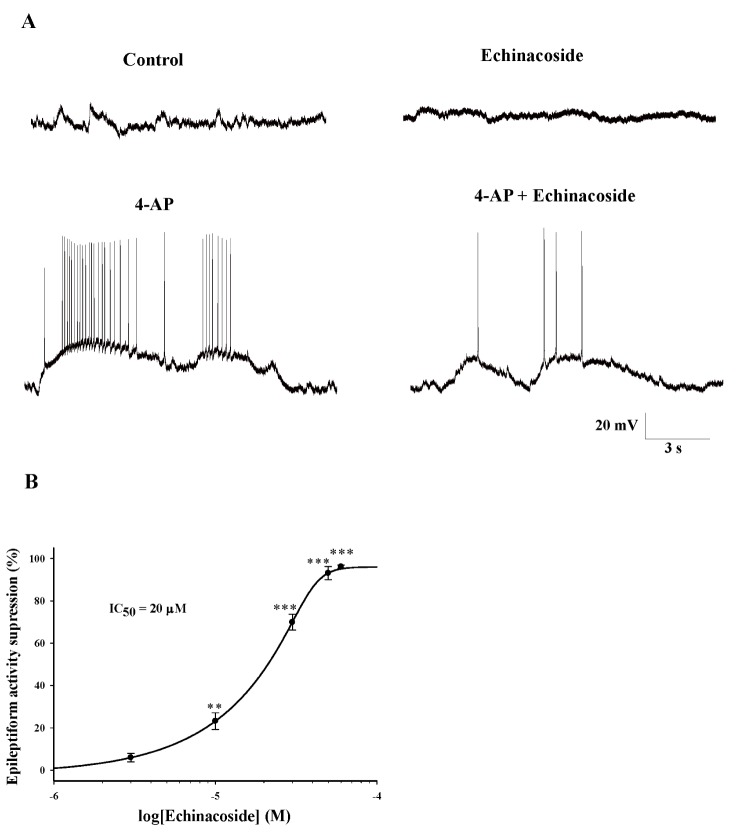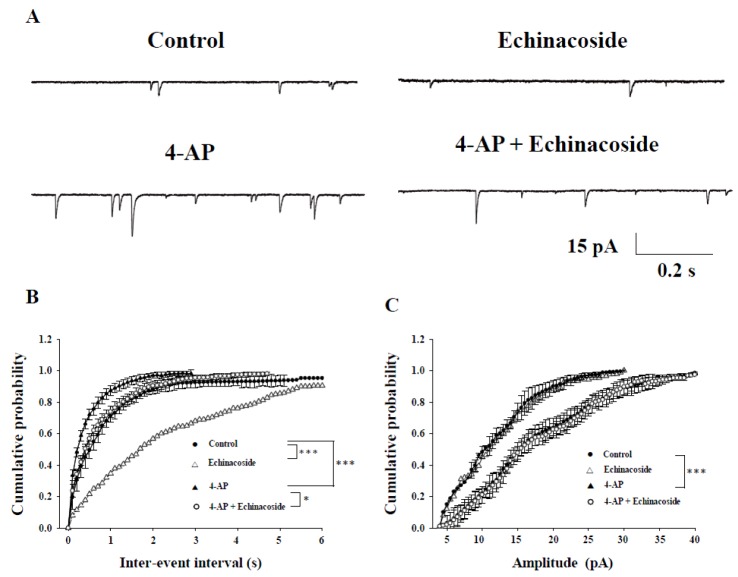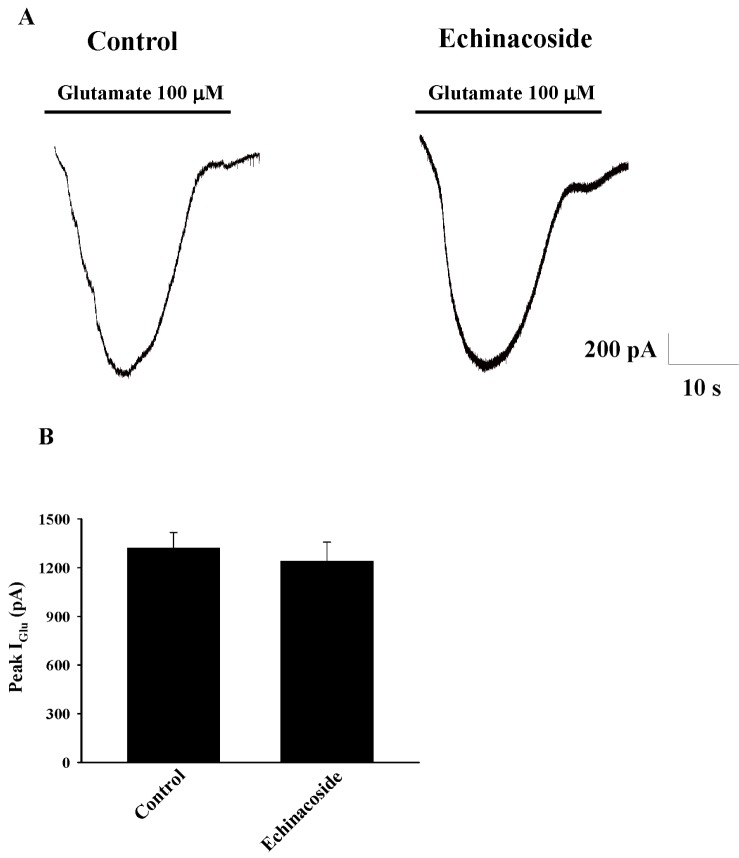Korean J Physiol Pharmacol.
2018 May;22(3):249-255. 10.4196/kjpp.2018.22.3.249.
Echinacoside, an active constituent of Herba Cistanche, suppresses epileptiform activity in hippocampal CA3 pyramidal neurons
- Affiliations
-
- 1Department of Anesthesiology, Far-Eastern Memorial Hospital, Pan-Chiao District, New Taipei 22060, Taiwan.
- 2School of Medicine, Fu Jen Catholic University, New Taipei 24205, Taiwan. med0003@mail.fju.edu.tw
- 3Department of Mechanical Engineering, Yuan Ze University, Taoyuan 320, Taiwan.
- 4Research Center for Chinese Herbal Medicine, College of Human Ecology, Chang Gung University of Science and Technology, Taoyuan 33303, Taiwan.
- KMID: 2410089
- DOI: http://doi.org/10.4196/kjpp.2018.22.3.249
Abstract
- Echinacoside, an active compound in the herb Herba Cistanche, has been reported to inhibit glutamate release. In this study, we investigated the effects of echinacoside on spontaneous excitatory synaptic transmission changes induced by 4-aminopyridine (4-AP), by using the in vitro rat hippocampal slice technique and whole-cell patch clamp recordings from CA3 pyramidal neurons. Perfusion with echinacoside significantly suppressed the 4-AP-induced epileptiform activity in a concentration-dependent manner. Echinacoside reduced 4-AP-induced increase in frequency of spontaneous excitatory postsynaptic currents (sEPSCs) but it did not affect the amplitude of sEPSCs or glutamate-activated currents, implicating a presynaptic mechanism of action. Echinacoside also potently blocked sustained repetitive firing, which is a basic mechanism of antiepileptic drugs. These results suggest that echinacoside exerts an antiepileptic effect on hippocampal CA3 pyramidal neurons by simultaneously decreasing glutamate release and blocking abnormal firing synchronization. Accordingly, our study provides experimental evidence that echinacoside may represent an effective pharmacological agent for treating epilepsy.
Keyword
MeSH Terms
Figure
Reference
-
1. Brodie MJ, French JA. Management of epilepsy in adolescents and adults. Lancet. 2000; 356:323–329. PMID: 11071202.
Article3. Löscher W. Animal models of drug-resistant epilepsy. Novartis Found Symp. 2002; 243:149–159. PMID: 11990774.
Article4. Rogawski MA, Löscher W. The neurobiology of antiepileptic drugs. Nat Rev Neurosci. 2004; 5:553–564. PMID: 15208697.
Article5. Sasaki K, Hatta S, Wada K, Ohshika H, Haga M. Anticonvulsant activity of bilobalide, a sesquiterpene in Ginkgo biloba L. leaves against chemical-induced and electroshock-induced convulsions in mice. Res Commun Biol Psychol Psychiatry. 1995; 20:145–156.6. Grunze H, Langosch J, von Loewenich C, Walden J. Modulation of neural cell membrane conductance by the herbal anxiolytic and antiepileptic drug aswal. Neuropsychobiology. 2000; (42 Suppl 1):28–32. PMID: 11093068.
Article7. Tu PF, Wang B, Deyama T, Zhang ZG, Lou ZC. Analysis of phenylethanoid glycosides of Herba cistanchis by RP-HPLC. Yao Xue Xue Bao. 1997; 32:294–300. PMID: 11499033.8. Zhao LX, Zhang CL, Zhao JX. Experience of WANG Guo-san in treating epilepsy. China J Tradit Chin Med Pharm. 2011; 6:25.9. Wang F, Wang WK. Chinese medicinal composition for treating epilepsy and preparation method thereof. Chinese Patent. CN 101797352 B. 2011. 7. 27.10. Zhu M, Lu C, Li W. Transient exposure to echinacoside is sufficient to activate Trk signaling and protect neuronal cells from rotenone. J Neurochem. 2013; 124:571–580. PMID: 23189969.
Article11. Wu CR, Lin HC, Su MH. Reversal by aqueous extracts of Cistanche tubulosa from behavioral deficits in Alzheimer's disease-like rat model: relevance for amyloid deposition and central neurotransmitter function. BMC Complement Altern Med. 2014; 14:202. PMID: 24968859.
Article12. Zhao Q, Gao J, Li W, Cai D. Neurotrophic and neurorescue effects of Echinacoside in the subacute MPTP mouse model of Parkinson's disease. Brain Res. 2010; 1346:224–236. PMID: 20478277.
Article13. Lu CW, Lin TY, Huang SK, Wang SJ. Echinacoside inhibits glutamate release by suppressing voltage-dependent Ca2+ entry and protein kinase C in rat cerebrocortical nerve terminals. Int J Mol Sci. 2016; 17:E1006. PMID: 27347934.14. Lasoń W, Chlebicka M, Rejdak K. Research advances in basic mechanisms of seizures and antiepileptic drug action. Pharmacol Rep. 2013; 65:787–801. PMID: 24145073.
Article15. Voskuyl RA, Albus H. Spontaneous epileptiform discharges in hippocampal slices induced by 4-aminopyridine. Brain Res. 1985; 342:54–66. PMID: 2994823.
Article16. Martín ED, Pozo MA. Valproate reduced synaptic activity increase induced by 4-aminopyridine at the hippocampal CA3-CA1 synapse. Epilepsia. 2004; 45:436–440. PMID: 15101824.
Article17. Rho JM, Sankar R. The pharmacologic basis of antiepileptic drug action. Epilepsia. 1999; 40:1471–1483. PMID: 10565572.
Article18. DeLorenzo RJ, Sombati S, Coulter DA. Effects of topiramate on sustained repetitive firing and spontaneous recurrent seizure discharges in cultured hippocampal neurons. Epilepsia. 2000; (41 Suppl 1):S40–S44. PMID: 10768299.
Article19. Rodríguez-Moreno A, Sihra TS. Presynaptic kainate receptor facilitation of glutamate release involves protein kinase A in the rat hippocampus. J Physiol. 2004; 557:733–745. PMID: 15107475.
Article20. Watts AE, Jefferys JG. Effects of carbamazepine and baclofen on 4-aminopyridine-induced epileptic activity in rat hippocampal slices. Br J Pharmacol. 1993; 108:819–823. PMID: 8467367.
Article21. Fernández de, Garduño J, Galván E, Buño W. Calciumactivated afterhyperpolarizations regulate synchronization and timing of epileptiform bursts in hippocampal CA3 pyramidal neurons. J Neurophysiol. 2006; 96:3028–3041. PMID: 16971683.22. Chapman AG. Glutamate and epilepsy. J Nutr. 2000; 130(4S Suppl):1043S–1045S. PMID: 10736378.
Article23. Bouron A. Modulation of spontaneous quantal release of neurotransmitters in the hippocampus. Prog Neurobiol. 2001; 63:613–635. PMID: 11164998.
Article24. Malgaroli A, Tsien RW. Glutamate-induced long-term potentiation of the frequency of miniature synaptic currents in cultured hippocampal neurons. Nature. 1992; 357:134–139. PMID: 1349728.
Article25. Manabe T, Renner P, Nicoll RA. Postsynaptic contribution to long-term potentiation revealed by the analysis of miniature synaptic currents. Nature. 1992; 355:50–55. PMID: 1346229.
Article26. Lampl I, Schwindt P, Crill W. Reduction of cortical pyramidal neuron excitability by the action of phenytoin on persistent Na+ current. J Pharmacol Exp Ther. 1998; 284:228–237. PMID: 9435183.
- Full Text Links
- Actions
-
Cited
- CITED
-
- Close
- Share
- Similar articles
-
- Neuronal Change in the Dentate and Hippocampus of Adrenalectomized and Adrenal Corticosteroid Injected Neonatal Rats
- Immunohistochemical Study on GTP-binding Rab6 Expression in the Hippocampal Cortices of the Alzheimer Brain
- The Effect of Benzathine Penicillin-induced Focal Interictal Epileptiform Discharges on the Expression Patterns of c-JUN Protein in the Rat Brain
- Anticonvulsant Effect of Flutamide in vitro Seizure Model
- p53 mRNA Expression after Hypoxia and Reoxygenation in Hippocampal CA1 and CA3 Regions






